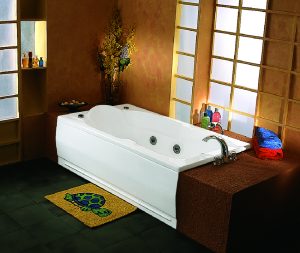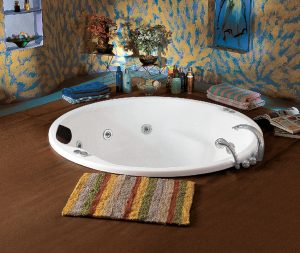Once you install a brand new bathtub as part of a bathroom remodel or renovation project it becomes an exciting experience. After putting careful thought into choosing the perfect tub to fit your needs, aesthetic tastes, and budget, it finally arrives at your home, ready to provide years of soaking relaxation.
But like any major investment, getting the most out of your new bathtub requires proper care and maintenance. With the right cleaning methods and care habits, you can keep your tub looking shiny and pristine for decades.
In this homeowner’s guide, we’ll walk through everything you need to know to care for a new bathtub. We’ll look at choosing suitable cleaners, establishing regular cleaning routines, preventing stubborn stains, importance of ventilation, re-caulking techniques, and tips to make your new tub last.
Choosing Tub-Safe Cleaning Supplies
It’s tempting to just use that bottle of kitchen or bathroom cleaner under the sink to clean your new bathtub. But not all cleaners are created equal when it comes to what’s best for maintaining a tub surface. Specialized tub cleaners are formulated to cut through the dirt, oils, hair products, and soap scum that accumulate on tubs without damaging the finish.
Steer clear of anything too abrasive or harsh. Scouring powders, stiff scrub brushes, and steel wool pads can actually erode or dull the surface over time, creating micro-scratches and swirls. Opt for cleaners specifically designed for bathtub cleaning and have ingredients to help dissolve residue and lift grime without scratching.
For most standard acrylic, fiberglass or porcelain tubs, a non-abrasive liquid cleanser, spray cleaner, or foaming gel bath cleaner will get the job done safely. Make sure any cleaner you use is intended for use on your particular tub material. Certain acids or cleaning agents can damage some surfaces.
When possible, avoid DIY cleaner combinations like ammonia and bleach that could interact and cause fumes. Also be wary of getting bath oils, bubbles baths, or bath salts on your tub as these can leave behind oily sticky residue. Read labels and only use products deemed tub-safe.
Set Up a Regular Cleaning Routine
Consistent cleaning is key to keeping a new bathtub sparkling. Daily and weekly cleaning sessions will prevent soap scum, oils, dirt and minerals from building up and becoming more stubborn to remove. Get into the habit of giving your tub a quick wipe down after each use.
Just taking a minute or two to dry water droplets and wipe away any lingering hair/soap residue will go a long way toward stopping buildup before it starts. Focus on spots where splashes collect like the tub floor, walls, fixtures, and shower doors.
Deep clean the entire tub at least once a week if not more. Working from top to bottom is usually easiest – start with the walls, then handles and fixtures, doors, and finally the tub floor. Check crevices and caulk lines carefully for any mildew growth. Give areas like jet vents an extra scrub with a small brush.
Always rinse cleaning products away thoroughly and wipe any wetness to promote drying. Lingering moisture invites mold and mildew problems. Squeegee the walls and doors after showering to eliminate pooling water and mineral deposits that could become etched or leave unsightly rings.
Making quick tub wipe downs part of your self-care routine will keep soap scum and grime from taking hold. A weekly deeper cleaning gives you a chance to fully sanitize all surfaces and restore that factory-fresh sheen.
Best Methods for Removing Stubborn Stains
Even with regular cleaning, bathtubs will inevitably become plagued by stubborn stains over time. Soap scum, hard water minerals, iron deposits, and mildew can discolor, etch or build up on tub surfaces. Catching these stains early improves your chances of removal.
Start by wiping away any wetness immediately after use before it dries and sets. Nevertheless, you’ll likely encounter difficult stains that require special treatment. For rust stains, try a pumice stone scrubbing but for persistent marks, use a rust remover product specifically designed for tubs.
To eliminate hard water stains, use white vinegar, club soda, or a cleaning solution made to dissolve mineral deposits and soap residue. For dotted black mildew stains, never use bleach which can react with tub materials. Choose a cleaner with antimicrobial ingredients made for mold and mildew.
For dingy soap scum rings, apply a liquid bathroom spray cleaner or tub-specific soap scum remover gel. Let it soak 5-10 minutes before scrubbing and rinsing clean. Repeat applications if needed for stubborn buildup. The sooner you treat difficult stains, the better chance of removing them without long-term damage.
Proper Ventilation Prevents Mold and Mildew
Ventilation is often overlooked but essential for caring for a new bathtub and controlling humidity. Bathrooms, especially during and after showering, generate a great deal of moist warm air – the perfect breeding ground for mold.
Be diligent about running your bath fan during and at least 10-15 minutes after showering. Also open a window whenever possible to allow fresh air to circulate and dry out the tub area. Make sure your bath fan is powerful enough to adequately clear humidity.
In addition to using exhaust fans, clean the fan cover itself about once a month to remove dust buildup that can impede airflow. Also periodically disinfect and vacuum out the fan ducts leading outside.
If your bathroom is still prone to excessive humidity, condensation and stuffiness, consider consulting an HVAC specialist about upgraded ventilation options. They can assess your needs and determine if solutions like a stronger ducted fan, inline fan, or ductless range hood would improve air exchange.
Proper ventilation coupled with wiping down wet areas and shower doors after use will help tremendously in preventing persistent mold issues.
Caulking and Grout Maintenance
The caulk seals and grout lines surrounding your new bathtub will require regular upkeep and renewal to stay mold-free and watertight. Caulk and grout are common problem areas because they absorb moisture and attract dirt and soap scum.
Inspect caulking annually and refresh anytime it looks worn, cracked, or discolored. Use a razor scraper or caulk removal tool to fully remove old caulking. Clean the area completely, then lay down a steady bead of quality silicone caulk designed for wet areas.
Tool the fresh caulk with a caulking sponge for a smooth finished look. Let cure fully for 24 hours before exposing to water. Silicone caulk contains fungicides to inhibit mold growth.
For grout, use a specialized stiff grout brush to periodically scrub and clean discolored lines. Let a grout pen or spray cleaner soak in for 10 minutes then scrub. This will prevent buildup of grime and oils that lead to dark ugly streaks of mold.
Staying on top of re-caulking and grout cleaning will result in a pristine tub surround that maintains its like-new appearance.
Tips for Extending Your Tub’s Lifespan
Follow these bathtub care principles consistently over the years, and your tub will continue looking freshly installed for decades rather than showing wear and damage. Developing good maintenance habits is key.
- Daily quick wipe downs
- Weekly deep cleaning sessions
- Immediately treating any stains/chips
- Using tub-specific cleaners
- Opening windows during/after bathing
- Re-caulking every 1-2 years
- Cleaning fan covers and ducts
- Avoiding abrasives that could scratch
In addition to regular care, also do a deep intensive cleaning 1-2 times per year. Thoroughly scrub all surfaces, clean fan ducts, treat stains and caulk, sanitize and seal grout, and use a tub polish or re-glazing kit to renew the protective finish.
For a fiberglass or acrylic tub, re-seal it every couple years to maintain the glossy surface. Avoid using abrasives or sitting heavy objects on the tub floor that could scratch or dent it. Harsh chemicals can degrade surfaces over time.
With porcelain enameled steel or cast iron tubs, take extra care about chipping or marring the baked-on enamel finish. Use non-abrasive cleaners and soft scrub pads only. Immediately touch up any chips to prevent further damage.
Treat your new bathtub with care right from the start and it will retain its like-new appeal and performance for many years before needing a replacement. Follow these tips and you can enjoy a long lifespan from your investment.
Summing Up
Installing a new bathtub can be one of the most exciting parts of remodeling a bathroom. Following proper maintenance and care guidelines will ensure your investment retains its pristine factory-fresh beauty for decades.
Use only tub-safe cleaners and soft scrub pads. Establish daily and weekly cleaning routines focused on wiping away wetness, scrubbing surfaces and treating stains early. Prevent mold issues through proper ventilation. Re-caulk and clean grout regularly. Avoid abrasives or harsh chemicals that could degrade the finish.
With consistent care and cleaning habits, your new bathtub from Woven Gold India will stay looking as immaculate as the day it was installed. Follow these tips and you’ll enjoy an endless amount of relaxing, refreshing baths for years to come!




